Deza M.M., Laurent M. Geometry of Cuts and Metrics
Подождите немного. Документ загружается.

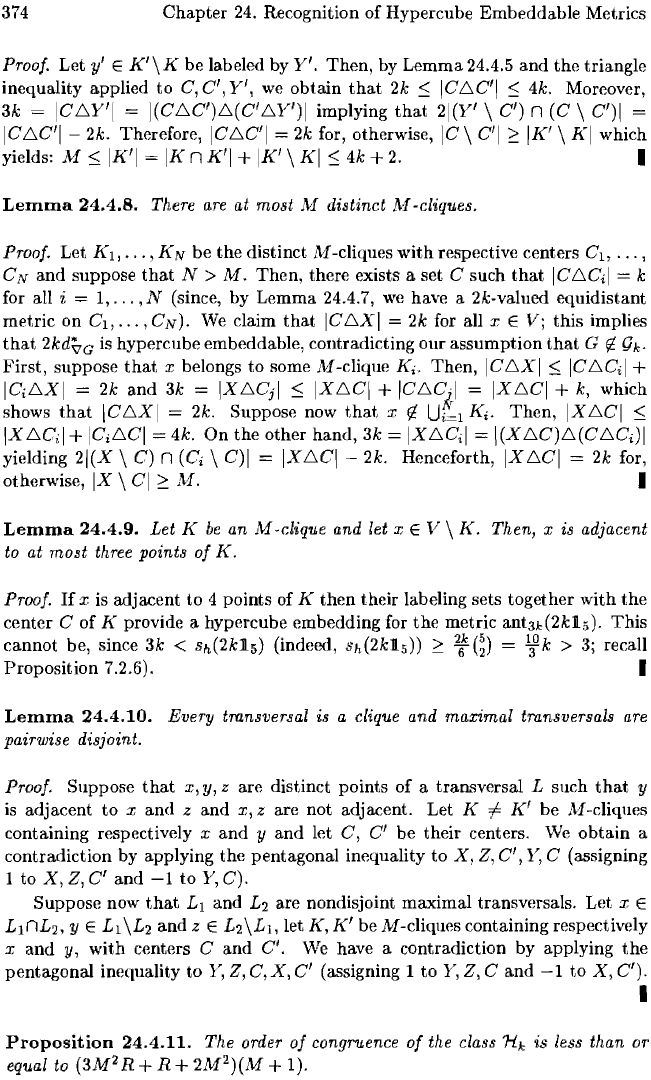
374
Chapter
24.
Recognition of Hypercube Embeddable Metrics
Proof. Let
y'
E
K'\K
be labeled by
y'.
Then, by
Lemma
24.4.5 and
the
triangle
inequality applied to
C,C',Y',
we
obtain
that
2k
:S
I C,0,C' I
:S
4k. Moreover,
3k
IC,0,y
t
l I(C,0,C'),0,(C',0,Y')1 implying
that
21(Y' \ C
t
) n
(C
\
C')I
=
IC,0,C'1
2k.
Therefore,
IC,0,C'1
=
2k
for, otherwise,
IC
\
C'I
~
IKt \
KI
which
yields:
M
:S
IK'I
IK
n
K'I
+ IKt \
KI
:S
4k
+
2.
I
Lemma
24.4.S.
There are
at
most
M distinct M -cliques.
Proof.
Let KI,
...
,
KN
be
the
distinct M-cliques
with
respective centers
Ct,
...
,
CN and suppose
that
1'1
> AI. Then, there exists a set C such
that
IC,0,Cil
= k
for all i
1,
...
,1'1
(since, by Lemma 24.4.7,
we
have a 2k-valued equidistant
metric on
CI,
...
,CN).
We
claim
that
IC,0,XI
2k
for all x E
V;
this implies
that
2kd'::;rc
is
hypercube embeddable, contradicting our assumption
that
G
i¢.
9k.
First,
suppose
that
x belongs to some M-clique
Ki.
Then,
IC,0,XI
:S
I
C,0,C
i
I +
I
Ci,0,X
I =
2k
and
3k
=
IX,0,C
j
l
:S
IX,0,CI
+
IC,0,CI
=
IX,0,CI
+ k, which
shows
that
IC,0,XI
= 2k. Suppose now
that
x
i¢.
UtI
K;.
Then,
IX,0,CI
:S
IX,0,Cil
+
IC
i
,0,CI
= 4k.
On
the
other hand,
3k
IX,0,Cil
I (X,0,C),0,(C,0,C
i
)
I
yielding
21(X
\
C)
n (C; \
C)I
IX,0,Cj
2k. Henceforth,
IX
,0,CI
=
2k
for,
otherwise,
IX
\
CI
~
M.
I
Lemma
24.4.9.
Let
K
be
an
M·clique
and let x E V \
K.
Then, x is adjacent
to
at
most
three points
of
K.
Proo/.
If
x is adjacent to 4 points
of
K
then
their labeling sets together
with
the
center C
of
K provide a hypercube embedding for
the
metric ant3k(2H5). This
cannot be, since
3k
<
sh(2k15)
(indeed,
sh(2k1
5
))
~
~m
=
1fk
> 3; recall
Proposition 7.2.6).
I
Lemma
24.4.10.
Every
transversal is a clique
and
maximal
transversals are
pairwise disjoint.
Proof.
Suppose
that
x,
y, z are distinct points
of
a transversal L such
that
y
is
adjacent to x
and
z and
x,
z are not adjacent. Let K f
K'
be M-cliques
containing respectively
x
and
y and let C, C' be their centers.
We
obtain
a
contradiction by applying
the
pentagonal inequality to
X,
Z,
C',
Y, C (assigning
1 to
X,
Z, C
t
and
-1
to
Y,
C).
Suppose now
that
and
L2
are nondisjoint maximal transversals. Let x E
L1
nL2,
yELl
\L2
and
z E L2
\L1,
let
K,
K'
be M -cliques containing respectively
x
and
y,
with
centers C
and
C
'
.
We
have a contradiction by applying
the
pentagonal inequality to
Y,
Z,
C,X,C'
(assigning 1 to Y, Z, C
and
-1
to
X,
C
'
).
I
Proposition
24.4.11.
The order
of
congruence
of
the class
1ik
is
less
than
or
equal to
(3M2R+
R+
2M2)(M
+ 1).
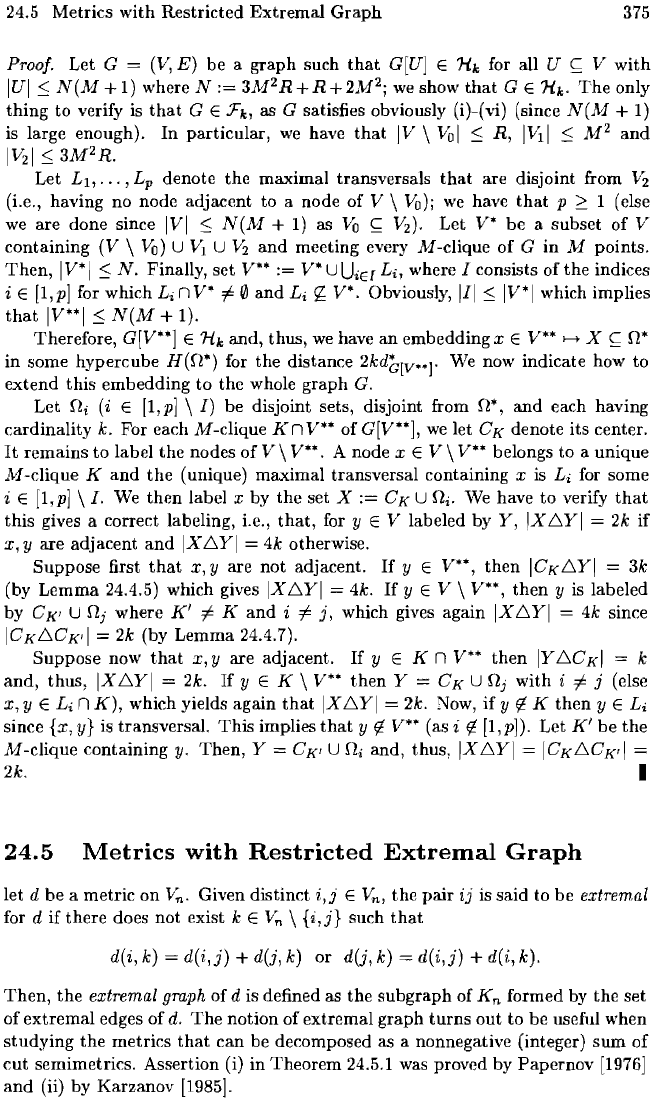
24.5 Metrics with Restricted Extremal
Graph
375
Proof. Let G =
(V,
E)
be a graph such
that
G[U]
E
11k
for all U
~
V
with
lUI::;
N(M
+
1)
where N
3M
2
R+ R+
2M2;
we
show
that
G E
11k.
The
only
thing
to verify is
that
G E
:Fk,
as G satisfies obviously (i)-(vi) (since
N(M
+
1)
is large enough).
In
particular,
we
have
that
IV
\
Vol
::;
R,
IVII
::;
M2
and
IViI
::;
3M
2
R.
Let L
I
,
...
,
Lp
denote the maximal transversals
that
are disjoint from
Vi
(Le., having no node adjacent to a node of V \
Vo);
we
have
that
p
~
1 (else
we
are done since
IVI
::;
N(M
+
1)
as
Vo
~
V
2
).
Let
V*
be a subset
of
V
containing
(V
\
Vo)
U
VI
U
Vi
and meeting every M-clique
of
G
in
M points.
Then,
IV*
I
::;
N.
Finally, set
V**
V*
U
UiE[
L
i
, where I consists
of
the
indices
i E [1,p] for which
LinV*
i 0
and
Li
~
V*.
Obviously, III
::;
IV*I
which implies
that
IV**I
::;
N(M
+ 1).
Therefore, G[V**] E
11k
and, thus,
we
have an embedding x E V**
f--+
X
~
fl*
in some hypercube
H(fl*)
for the distance 2kd
O
[v
••
j'
We
now indicate how to
extend this embedding to the whole graph
G.
Let
fl.
(i
E [1,p] \ I) be disjoint sets, disjoint from
fl*,
and
each having
cardinality
k. For each M-clique K n V** of G[V**],
we
let C
K
denote its center.
I t remains
to
label the nodes of V \ V**. A node x E V \
V**
belongs to a unique
At-clique
K
and
the
(unique) maximal transversal containing x
is
Li
for some
i E [1,p] \
I.
We
then
label x by the set X
:=
CK U
fl
i
.
We have to verify
that
this gives a correct labeling, i.e.,
that,
for y E V labeled by
Y,
IX
6YI
=
2k
if
x, y are adjacent
and
IX
6YI
= 4k otherwise.
Suppose first
that
x,
yare
not adjacent.
If
y E V**,
then
IC
K
6YI
=
3k
(by
Lemma
24.4.5) which gives IX
6YI
= 4k.
If
Y E V \ V**,
then
y
is
labeled
by CK'
U
flj
where
K'
i K
and
i i
j,
which gives again
IX6YI
=
4k
since
ICK6CK'I
2k
(by Lemma 24.4.7).
Suppose now
that
x,
y are adjacent.
If
y E K n V**
then
IY
6C
KI
k
and, thus,
IX6YI
= 2k.
If
y E K \
V**
then
Y =
CK
U
flj
with i i j (else
x, y E
Li
n
K),
which yields again
that
IX
6YI
=
2k.
~ow,
if y
if.
K
then
y E
Li
since {x, y} is transversal. This implies
that
y
if.
V··
(as i
if.
[l,pJ). Let
K'
be the
M-dique
containing
y.
Then, Y = C
K
, U
fli
and, thus, IX
6YI
ICK6CK,I
2k. I
24.5
Metrics
with
Restricted
Extremal
Graph
let d be a metric
on
V
n
.
Given distinct
i,j
E V
n
,
the
pair
ij
is said to be extremal
for d if there does not exist k E
Vn
\
{i,j}
such
that
d(i, k) =
d(i,j)
+ d(j, k)
or
d(j, k)
d(i,j)
+ d(i, k).
Then,
the
extremal graph
of
d is defined as the subgraph of
Kn
formed by the set
of extremal edges of
d.
The
notion of extremal graph
turns
out
to be useful when
studying the metrics
that
can be decomposed as a nonnegative (integer)
sum
of
cut
semimetrics. Assertion (i) in Theorem 24.5.1 was proved by Papernov
[1976J
and
(ii) by Karzanov
[1985].
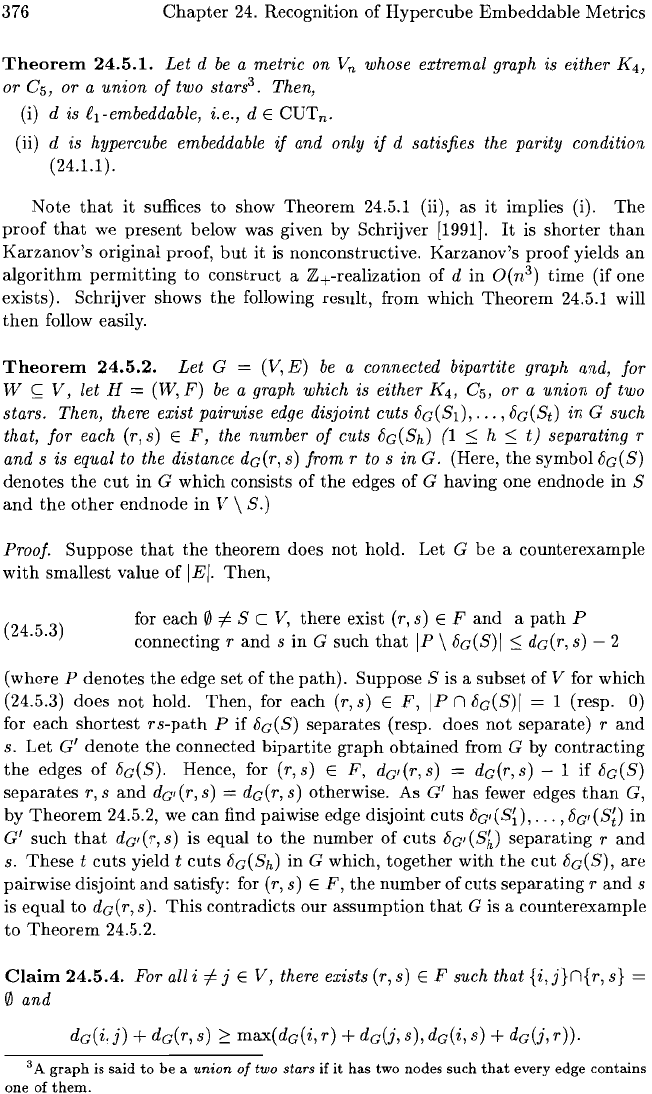
376
Chapter
24.
Recognition of
Hypercube
Embeddable
Metrics
Theorem
24.5.1.
Let
d
be
a
metric
on
Vn
whose
extremal
graph is
either
K
4
,
or
Os,
or
a
union
of
two
st
ars
3.
Then,
(i)
d is iI-embeddable, i.e.,
dE
CUT
n
•
(ii) d is hypercube embeddable
if
and only
if
d satisfies the
parity
condition
(24.1.1).
Note
that
it
suffices
to
show
Theorem
24.5.1 (ii), as
it
implies (i).
The
proof
that
we present below was given by Schrijver [1991].
It
is
shorter
than
Karzanov's
original proof,
but
it
is nonconstructive.
Karzanov's
proof
yields
an
algorithm
permitting
to
construct
a
Z+-realization
of d
in
O(n
3
)
time
(if one
exists). Schrijver shows
the
following result, from which
Theorem
24.5.1 will
then
follow easily.
Theorem
24.5.2.
Let
G = (V,
E)
be
a connected bipartite graph and,
for
W
C;;;
V,
let H = (W,
F)
be
a graph which is
either
K
4
,
Os,
or
a
union
of
two
stars.
Then,
there
exist
pairwise edge
disjoint
cuts
Dc(SI),
...
,Dc(St)
in
G such
that,
for
each (r, s) E
F,
the
number
of
cuts Dc(Sh)
(1
:::;
h
:::;
t)
separating r
and
s is equal to the distance
dc(r,
s)
from
r to s
in
G. (Here,
the
symbol
Dc(S)
denotes
the
cut
in
G which consists
of
the
edges of G having one
endnode
in
S
and
the
other
endnode
in
V \ S.)
Proof.
Suppose
that
the
theorem
does
not
hold.
Let
G
be
a
counterexample
with
smallest
value
of
lEI.
Then,
(24.5.3)
for each
0
=f.
S c V,
there
exist (r, s) E F
and
a
path
P
connecting
rand
s
in
G such
that
IP \ Dc(S)1
:::;
dc(r,
s) - 2
(where
P
denotes
the
edge set
of
the
path).
Suppose
S is a
subset
of V for which
(24.5.3) does
not
hold.
Then,
for each
(r,s)
E
F,
IPnDc(S)1
= 1 (resp. 0)
for each
shortest
rs-path
P
if
Dc(S)
separates
(resp. does not
separate)
rand
s.
Let
G'
denote
the
connected
bipartite
graph
obtained
from G by
contracting
the
edges
of
Dc(S).
Hence, for
(r,s)
E
F,
dCI(r,s)
=
dc(r,s)
- 1
if
Dc(S)
separates
r,
sand
dCI(r, s) =
dc(r,
s) otherwise. As
G'
has fewer edges
than
G,
by
Theorem
24.5.2,
we
can
find paiwise edge disjoint
cuts
Dc,(SD,
...
,
DCI(S~)
in
G'
such
that
dC1(r,s) is equal
to
the
number
of
cuts
DC1(SU
separating
rand
s.
These
t
cuts
yield t
cuts
Dc(Sh)
in
G which,
together
with
the
cut
Dc(S),
are
pairwise disjoint
and
satisfy: for
(r,
s) E
F,
the
number
of
cuts
separating
rand
s
is
equal
to
dc(r,
s).
This
contradicts
our
assumption
that
G is a
counterexample
to
Theorem
24.5.2.
Claim
24.5.4.
For
alli
=f.j E
V,
there exists
(r,s)
E F such
that
{i,j}n{r,
s}
=
o
and
dc(
i,
j)
+
dc(r,
s)
2:
max(
dc(i,
r)
+
dc(j,
s),
dc
(i, s) +
dc(j,
r)).
3 A
graph
is
said
to
be
a union
of
two stars if
it
has
two
nodes
such
that
every
edge
contains
one
of
them.
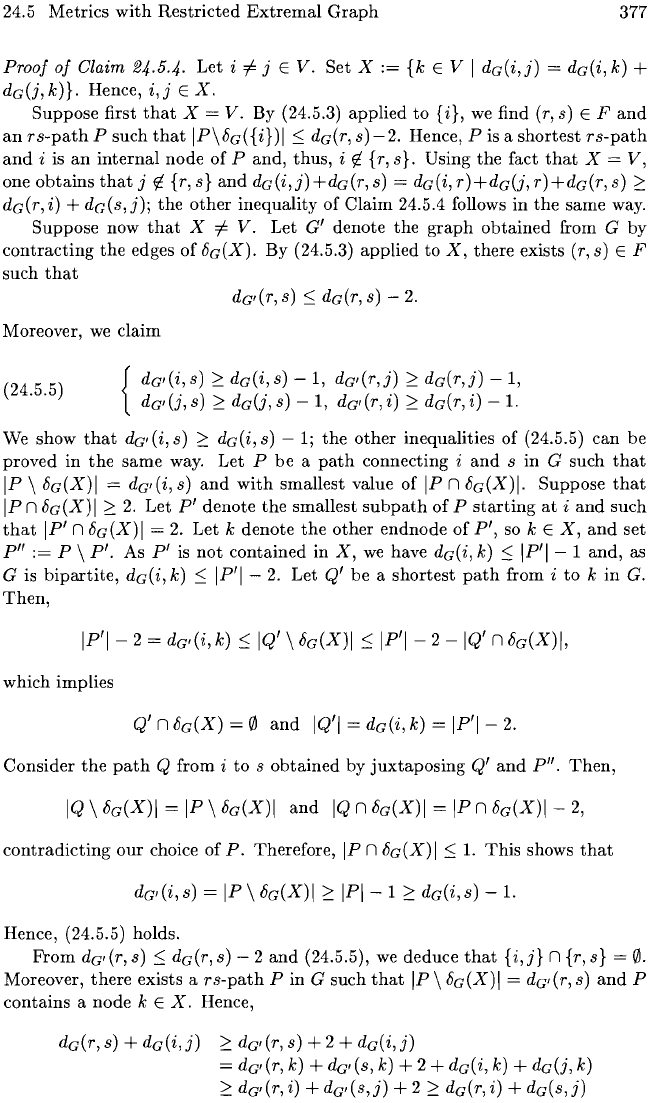
24.5
Metrics
with
Restricted
Extremal
Graph
377
Proof
of
Claim
24.5.4.
Let
i
=1=
j E
V.
Set
X
:=
{k
E V I dG(i,j) = dG(i, k) +
dG(j,k)}.
Hence,
i,j
EX.
Suppose
first
that
X =
V.
By
(24.5.3)
applied
to
{i}, we find (r,s) E F
and
an
rs-path
P
such
that
IP\b
G
(
{i})1
~
dG(r,
s)
-2.
Hence, P is a
shortest
rs-path
and
i is
an
internal
node
of
P
and,
thus,
i
rt
{r, s}.
Using
the
fact
that
X =
V,
one
obtains
that
j
rt
{r, s}
and
dG(i,
j)
+dG(r,
s)
= dG(i, r) +dG(j, r) +dG(r, s)
;:::
dG(r, i) +
dc(s,
j);
the
other
inequality
of
Claim
24.5.4 follows
in
the
same
way.
Suppose
now
that
X
=1=
V.
Let
G'
denote
the
graph
obtained
from G
by
contracting
the
edges
of
bG(X).
By
(24.5.3)
applied
to
X,
there
exists
(r,
s) E F
such
that
dG,(r,
s)
~
dG(r,
s)
- 2.
Moreover, we
claim
(24.5.5)
{
dG,(i,s);::: dG(i,s)
-1,
dG,(r,j)
;:::
dG(r,j)
-1,
dG,(j,s)
;:::
dG(j,s)
-1,
dG,(r,i);:::
dG(r,i)-1.
We
show
that
dG'
(i, s)
;:::
dG(i,
s)
-
1;
the
other
inequalities
of
(24.5.5)
can
be
proved
in
the
same
way.
Let
P
be
a
path
connecting
i
and
s
in
G
such
that
IF
\ bG(X)1 = dG,(i,s)
and
with
smallest
value
of
IF
n bG(X)I.
Suppose
that
IP
n bG(X)1
;:::
2.
Let
P'
denote
the
smallest
subpath
of
P
starting
at
i
and
such
that
IP'
n bG(X)1 =
2.
Let
k
denote
the
other
endnode
of
P',
so k E
X,
and
set
P"
:=
P \ P'. As
P'
is
not
contained
in
X,
we have dG(i, k)
~
IP'I- 1
and,
as
G is
bipartite,
dG(i, k)
~
IP'I
-
2.
Let
Q'
be
a
shortest
path
from
i
to
k
in
G.
Then,
IP'I
- 2 = dG,(i, k)
~
IQ'
\
bG(X)1
~
IF'I
- 2 -IQ' n bG(X)I,
which
implies
Q'
n bG(X) = 0
and
IQ'I
= dG(i, k) = IP'I-
2.
Consider
the
path
Q
from
i
to
s
obtained
by
juxtaposing
Q'
and
P".
Then,
IQ
\ bG(X)1 =
IP
\
bG(X)1
and
IQ
n
bG(X)1
=
IP
n
bG(X)1
-
2,
contradicting
our
choice
of
P.
Therefore,
IP
n
bG(X)1
~
1.
This
shows
that
dG,(i,s) = IF\bG(X)I;::: IFI-l;:::
dG(i,s)-1.
Hence, (24.5.5) holds.
From
dG'
(r,
s)
~
dG(r,
s) - 2
and
(24.5.5), we
deduce
that
{i,
j}
n {r, s} =
0.
Moreover,
there
exists
a
rs-path
P
in
G
such
that
IP
\
bG(X)1
= dG,(r,
s)
and
P
contains
a
node
k
EX.
Hence,
dG(r,
s)
+ dG(i,j)
;:::
dG,(r, s) + 2 + dG(i,j)
= dG,(r, k) + dG,(s, k) + 2 + dG(i, k) + dG(j, k)
;:::
dG,(r,i) + dG,(s,j) +
2;:::
dG(r,i) + dG(s,j)
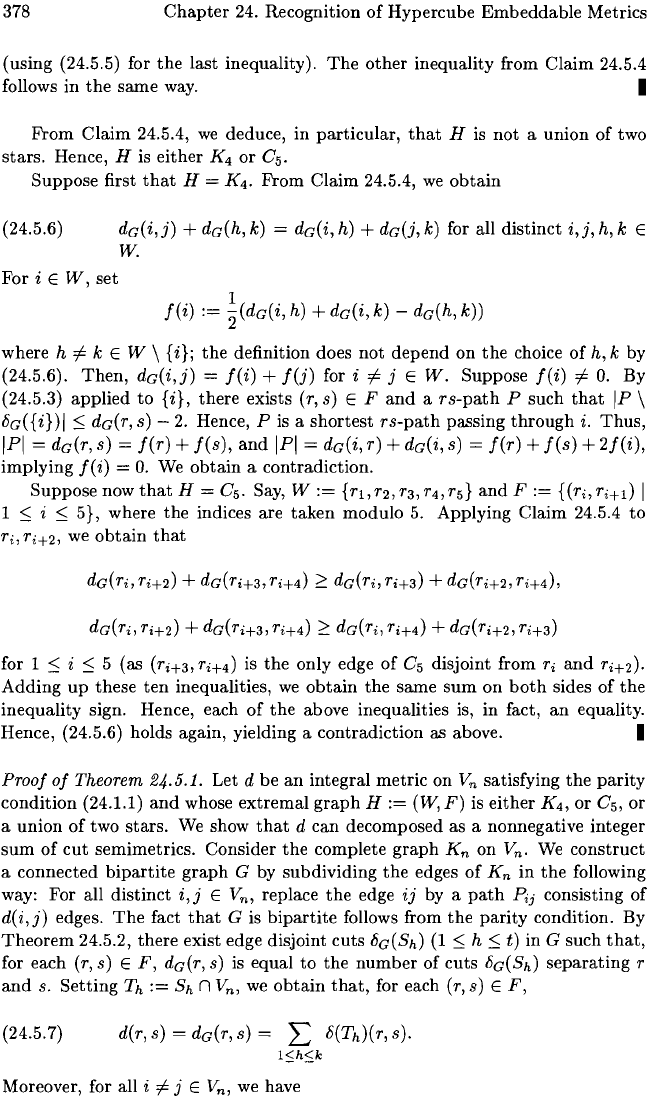
378
Chapter
24. Recognition
of
Hypercube
Embeddable
Metrics
(using (24.5.5) for
the
last inequality).
The
other
inequality from
Claim
24.5.4
follows
in
the
same
way. I
From
Claim
24.5.4,
we
deduce, in
particular,
that
H
is
not
a union
of
two
stars.
Hence, H is
either
K4
or
C
5
.
Suppose
first
that
H = K
4
•
From
Claim 24.5.4,
we
obtain
(24.5.6)
For
i E
W,
set
da(i,j)
+ da(h,
k)
= da(i,
h)
+ da(j,
k)
for all
distinct
i,j,
h,
k E
W.
1
f(i)
:=
"2(da(i,
h)
+ da(i,
k)
- da(h, k))
where h
=1=
k E W \ {i};
the
definition does
not
depend
on
the
choice
of
h, k by
(24.5.6).
Then,
da(i,j)
=
f(i)
+
f(j)
for i
=1=
JEW.
Suppose
f(i)
=1=
O.
By
(24.5.3)
applied
to
{i},
there
exists (r,s) E F
and
a
rs-path
F such
that
IF
\
oa(
{i})1
:s:
da(r, s) -
2.
Hence, F
is
a
shortest
rs-path
passing
through
i.
Thus,
IFI
= da(r,
s)
=
f(r)
+
f(s),
and
IFI
= da(i, r) + da(i, s) =
f(r)
+
f(s)
+
2f(i),
implying
f(i)
=
o.
We
obtain
a contradiction.
Suppose
now
that
H = C
5
. Say,
W:=
{rl,r2,r3,r4,r5}
and
F:=
{(ri,ri+1) I
1
:s:
i
:s:
5}, where
the
indices are
taken
modulo
5.
Applying Claim 24.5.4
to
ri,
ri+2,
we
obtain
that
da(ri,
ri+2)
+ d
a
(ri+3,
riH)
2::
da(ri'
riH)
+ da(ri+2'
ri+3)
for 1
:s:
i
:s:
5 (as
(ri+3,
riH)
is
the
only edge
of
C5
disjoint from
ri
and
ri+2).
Adding
up
these
ten
inequalities,
we
obtain
the
same
sum
on
both
sides
of
the
inequality sign. Hence, each
of
the
above inequalities is, in fact,
an
equality.
Hence, (24.5.6) holds again, yielding a contradiction as above.
I
Proof
of
Theorem 24.5.1. Let d
be
an
integral metric on
Vn
satisfying
the
parity
condition (24.1.1)
and
whose
extremal
graph
H
:=
(w,
F)
is
either
K
4
,
or
C
5
,
or
a
union
of
two stars. We show
that
d can decomposed as a nonnegative integer
sum
of
cut
semimetrics. Consider
the
complete
graph
Kn
on
V
n
. We
construct
a
connected
bipartite
graph
G by subdividing
the
edges
of
Kn
in
the
following
way: For all
distinct
i,
j E V
n
,
replace
the
edge
ij
by a
path
Fij consisting
of
d(i,j)
edges.
The
fact
that
G is
bipartite
follows from
the
parity
condition.
By
Theorem
24.5.2,
there
exist edge disjoint
cuts
0a(Sh)
(1
:s:
h
:s:
t)
in
G such
that,
for each
(r,
s) E
F,
da(r, s)
is
equal
to
the
number
of
cuts
0a(Sh)
separating
r
and
s.
Setting
Th
:=
Sh
n V
n
,
we
obtain
that,
for each
(r,
s)
E
F,
(24.5.7)
d(r, s) = da(r, s) = L o(Th)(r, s).
lShSk
Moreover, for all i
=1=
j E V
n
,
we have
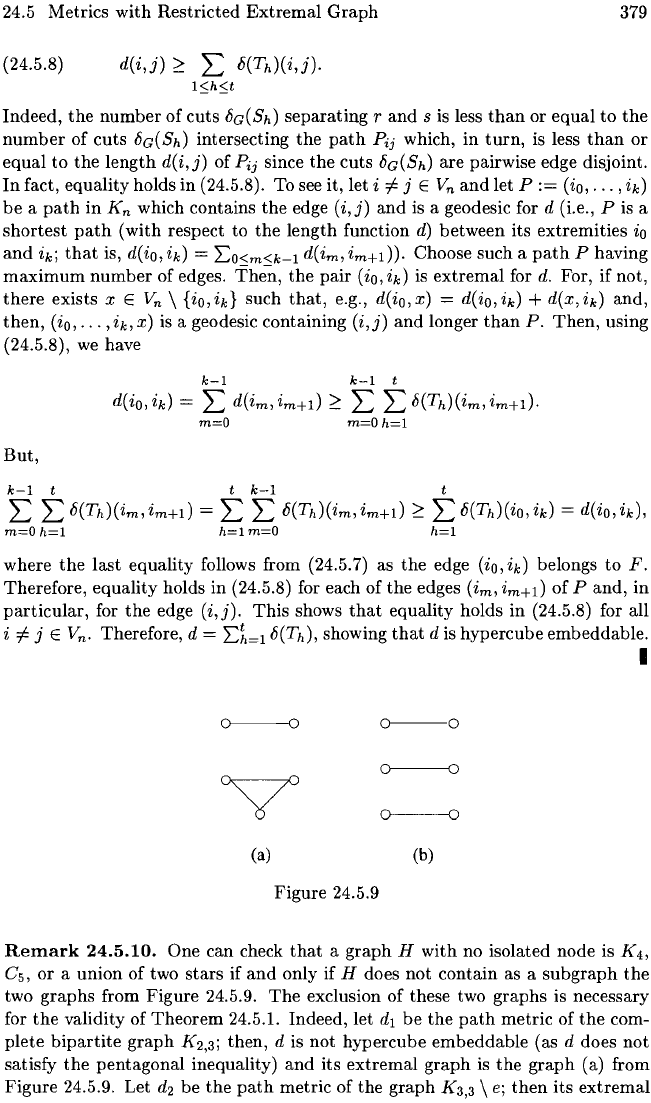
24.5 Metrics with Restricted
Extremal
Graph
379
(24.5.8)
d(i,j)
~
2:
b(Th)(i,j).
l:Sh:St
Indeed,
the
number
of
cuts
bC(Sh) separating
rand
s is less
than
or equal
to
the
number
of
cuts
bC(Sh) intersecting
the
path
Pij
which,
in
turn,
is less
than
or
equal
to
the
length
d(i,j)
of P
ij
since
the
cuts bC(Sh) are pairwise edge disjoint.
In
fact, equality holds
in
(24.5.8). To see it, let i
t=
j E
Vn
and
let P
:=
(io,
...
,ik)
be
a
path
in
Kn
which contains
the
edge
(i,j)
and
is a geodesic for d (Le., P is a
shortest
path
(with respect to
the
length function
d)
between its extremities
io
and
ik;
that
is, d(io, ik) =
L:O<m<k-l
d(im,
im+d).
Choose such a
path
P having
maximum
number
of edges.
Then,
the
pair
(io, ik)
is
extremal
for
d.
For, if not,
there
exists x E
Vn
\
{io,id
such
that,
e.g., d(io,x) = d(io,ik) + d(x,ik) and,
then,
(i
o
,
...
, ik, x) is a geodesic containing
(i,j)
and
longer
than
P.
Then,
using
(24.5.8), we have
k-l k-l
t
d(io, ik) =
2:
d(im' i
m
+
1
)
~
2: 2:
b(Th)(i
m
,
im+l).
m=O
m=O
h=l
But,
k-l
t t
k-l
t
2: 2:
b(Th)(im'
im+d
=
2: 2:
b(Th)(i
m
,
im+d
~
2:
b(Th)(io, ik) = d(io, ik),
m=O
h=l
h=l
m=O
h=l
where
the
last
equality follows from (24.5.7) as
the
edge (io,ik) belongs
to
F.
Therefore, equality holds
in
(24.5.8) for each of
the
edges (im'
im+l)
of
P and,
in
particular,
for
the
edge
(i,j).
This
shows
that
equality holds
in
(24.5.8) for all
i
t=
j E V
n
.
Therefore, d =
L:~=l
b(T
h
),
showing
that
d is hypercube embeddable.
I
0----0
0----0
0----0
0----0
(a)
(b)
Figure 24.5.9
Remark
24.5.10.
One can check
that
a
graph
H with no isolated node is K
4
,
C
5
,
or
a union of two
stars
if
and
only if H does
not
contain as a
subgraph
the
two
graphs
from Figure 24.5.9.
The
exclusion of these two graphs is necessary
for
the
validity of
Theorem
24.5.1. Indeed, let d
1
be
the
path
metric of
the
com-
plete
bipartite
graph
K
2
,3;
then, d is
not
hypercube embeddable (as d does not
satisfy
the
pentagonal
inequality)
and
its
extremal
graph
is
the
graph
(a) from
Figure
24.5.9. Let d
2
be
the
path
metric of the
graph
K3,3
\
e;
then
its
extremal

380
Chapter
24.
Recognition
of
Hypercube Embeddable Metrics
graph
is
the
graph (b) from Figure 24.5.9
and
d2
is
not
hypercube embeddable
(as
it contains d
1
as a subdistallce). (In fact,
both
dl
and
d2
lie on extreme rays
of
the semimetric cone.) I
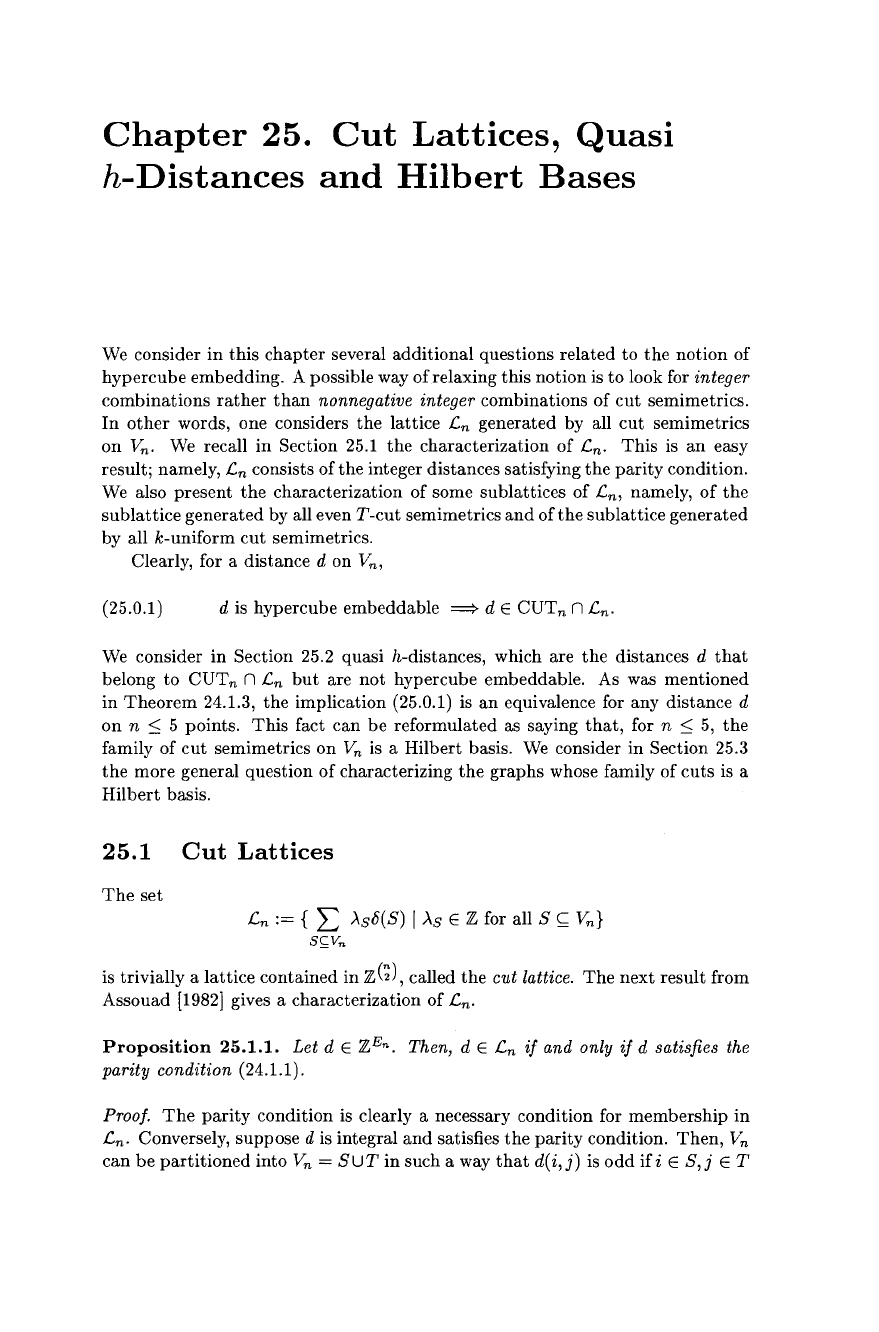
M.M. Deza, M. Laurent, Geometry of Cuts and Metrics, Algorithms and Combinatorics 15,
DOI 10.1007/978-3-642-04295-9_25, © Springer-Verlag Berlin Heidelberg 2010
Chapter
25.
Cut
Lattices,
Quasi
h-Distances
and
Hilbert
Bases
We consider
in
this
chapter
several additional questions related to
the
notion of
hypercube
embedding. A possible way
of
relaxing this notion is
to
look for integer
combinations
rather
than
nonnegative integer combinations
of
cut
semimetrics.
In
other
words, one considers
the
lattice Ln generated by all
cut
semimetrics
on
V
n
. We recall
in
Section 25.1
the
characterization
of
Ln.
This
is
an
easy
result; namely, Ln consists
of
the
integer distances satisfying
the
parity
condition.
We also present
the
characterization
of
some sublattices
of
L
n
,
namely,
of
the
sublattice
generated
by all even
T-cut
semimetrics
and
of
the
sublattice generated
by all k-uniform
cut
semimetrics.
Clearly, for a distance
d on V
n
,
(25.0.1 ) d is hypercube embeddable
===>
d E
CUTn
n Ln.
We consider
in
Section 25.2 quasi h-distances, which are
the
distances d
that
belong to
CUTn
n Ln
but
are
not
hypercube embeddable. As was mentioned
in
Theorem
24.1.3,
the
implication (25.0.1) is
an
equivalence for any distance d
on
n
::;
5 points.
This
fact
can
be
reformulated as saying
that,
for n
::;
5,
the
family
of
cut
semimetrics
on
Vn
is
a Hilbert basis. We consider
in
Section 25.3
the
more general question
of
characterizing
the
graphs
whose family
of
cuts
is a
Hilbert
basis.
25.1
The
set
Cut
Lattices
Ln
:=
{ L >'so(8) I
>'s
E Z for all 8
<:;;
V
n
}
SC;;Vn
is trivially a
lattice
contained
in
Z(;),
called
the
cut
lattice.
The
next
result from
Assouad
[1982]
gives a characterization
of
Ln.
Proposition
25.1.1.
Let
dE
ZEn.
Then,
dE
Ln
if
and only
if
d satisfies the
parity condition (24.1.1).
Proof.
The
parity
condition is clearly a necessary condition for
membership
in
Ln.
Conversely, suppose d is integral
and
satisfies
the
parity
condition.
Then,
Vn
can
be
partitioned
into
Vn
= 8 U T
in
such a way
that
d( i,
j)
is
odd
if
i E
8,
JET
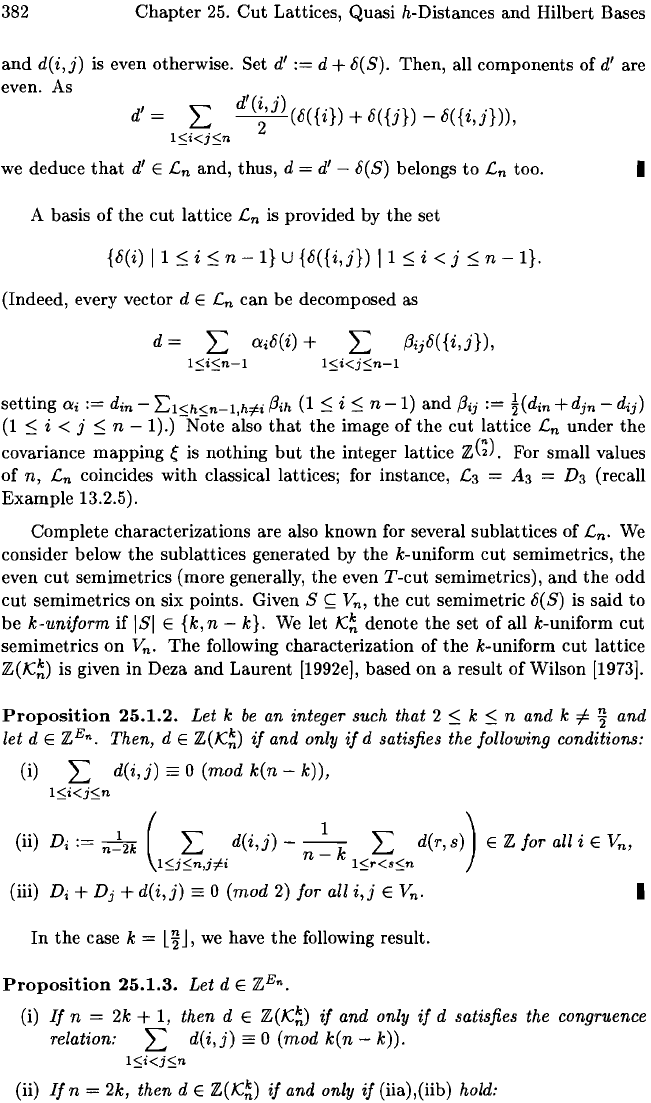
382
Chapter
25.
Cut
Lattices, Quasi h-Distances
and
Hilbert Bases
and
d(i,j)
is even otherwise. Set d'
:=
d + 8(8).
Then,
all components
of
d' are
even. As
d'=
L
d'(i
j
)(8({i})+8({j})-8({i,j})),
l:'O:i<j:'O:n
we deduce
that
d' E
Ln
and, thus, d = d' - 8(8) belongs
to
Ln
too.
I
A basis
of
the
cut
lattice
Ln
is provided by
the
set
{8(i)
11
SiS
n - I} U {8({i,j})
11
S i < j S n - I}.
(Indeed, every vector d E
Ln
can
be decomposed as
d = L
ai
8
(i) +
fJ
ij
8(
{i,j}),
l:'O:i:'O:n-l l:'O:i<j:'O:n-l
setting
ai
:=
din -
Ll:'O:h:'O:n-l,hi-i
fJih
(1
SiS
n
-1)
and
fJij
:=
!(din
+djn
-
dij)
(1
S i < j S n - 1).) Note also
that
the
image
of
the
cut
lattice
Ln
under
the
covariance
mapping
e is nothing
but
the
integer lattice Z(;). For small values
of
n,
Ln
coincides
with
classical lattices; for instance, L3 =
A3
= D3 (recall
Example
13.2.5).
Complete characterizations are also known for several sublattices
of
Ln.
We
consider below
the
sublattices generated by
the
k-uniform
cut
semimetrics,
the
even
cut
semimetrics (more generally,
the
even
T-cut
semimetrics),
and
the
odd
cut
semimetrics
on
six points. Given 8
~
V
n
,
the
cut semimetric 8(8) is
said
to
be
k-uniform
if
181
E
{k,n
-
k}.
We
let
K~
denote
the
set
of
all k-uniform
cut
semimetrics
on
V
n
.
The
following characterization
of
the
k-uniform
cut
lattice
Z(K~)
is given in Deza
and
Laurent
[1992eJ,
based
on
a result
of
Wilson [1973].
Proposition
25.1.2.
Let
k
be
an
integer
such
that
2 S k S
nand
k
=I-
~
and
let
d E ZEn.
Then,
d E
Z(K~)
if
and
only
if
d
satisfies
the following
conditions:
(i)
L
d(i,j)
==
0
(mod
k(n
-
k)),
l:'O:i<j:'O:n
(ii)
Di
:=
n!2k
( ,L,
d(i,j)
- n
~
k L d(r,
S))
E Z
for
all i E V
n
,
l:'O:J:'O:nJi-'
l:'O:r<s:'O:n
(iii)
Di
+ D
j
+
d(i,j)
==
0
(mod
2)
for
all
i,j
E V
n
.
I
In
the
case k = L I
J,
we
have
the
following result.
Proposition
25.1.3.
Let
d E ZEn.
(i)
If
n =
2k
+ 1,
then
d E
Z(K~)
if
and
only
if
d satisfies
the
congruence
relation: L
d(i,j)
==
0
(mod
k(n
-
k)).
l:'O:i<j:'O:n
(ii)
If
n =
2k,
then
d E
Z(K~)
if
and
only
if
(iia),(iib) hold:
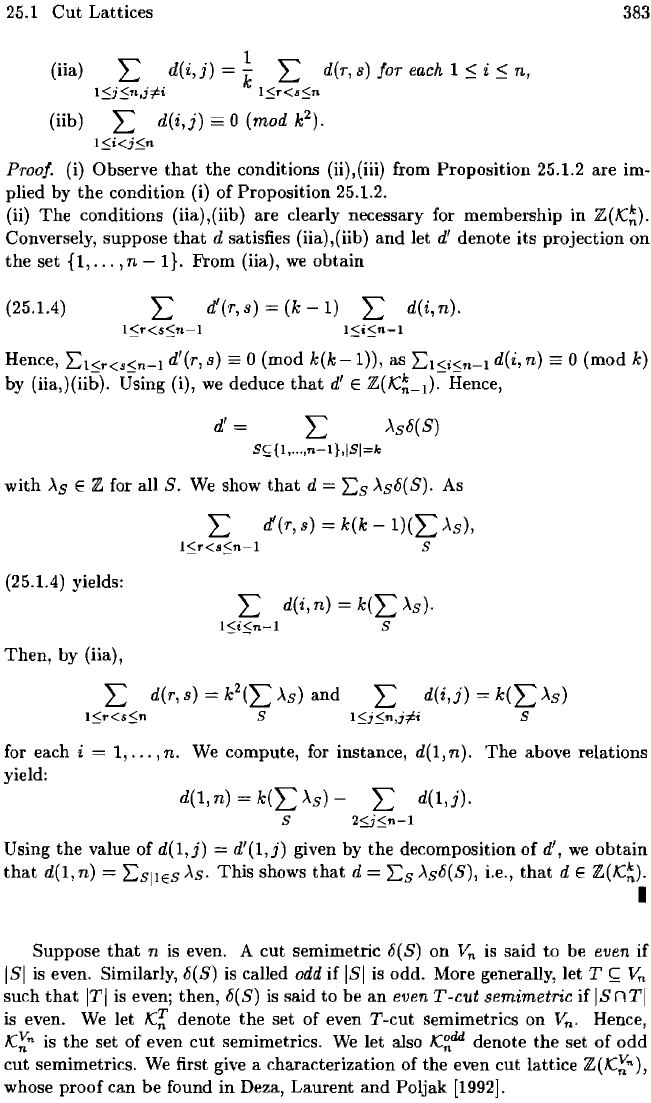
25.1
Cut
Lattices
383
1
k E
d(r,s)
for
each
1
~
i
~
n,
l.:Sr<sSn
(iia) E d(i,
j)
(iib) E
d(i,j)
0
(mod
k
2
).
l.:Si<i.:Sn
Proof. (i) Observe
that
the conditions (ii),(iii) from Proposition 25.1.2
are
im-
plied by
the
condition (i)
of
Proposition 25.1.2.
(ii)
The
conditions (iia),(iib) are clearly necessary for membership in
Z(K~).
Conversely, suppose
that
d satisfies (iia),(iib)
and
let
d'
denote its projection
on
the
set {I,
...
, n
-I}.
:From
(iia),
we
obtain
(25.1.4)
d!(r,s)=(k
1)
E
d(i,n).
l.:Sr<sSn-l
Hence,
Ll<r<s<n-l
d'(r,s)
0 (mod k(k
1»,
as
Ll<i<n-l
d(i,n)
==
0 (mod
k)
by (iia,)(iib). Using (i),
we
deduce
that
d'
E
Z(K~_l)~
Hence,
d'
>'s8(S)
S<;{l, ...
,n-l
},ISI=k
with
>'s
E Z for all
S.
We
show
that
d =
Ls
>'s8(S). As
E d!(r,s)
k(k-1)(E>.s),
l.:Sr<s.:Sn-l
s
(25.1.4) yields:
E d(i, n) =
k(E
>'s).
l.:Si.:Sn-l S
Then,
by (iia),
E d(r,
s)
=
k2(E
>.s)
and
E
d(i,j)
=
k(E
>.s)
l.:Sr<s.:Sn S
l':sjSn,jfi
S
for each i = 1,
...
,no
We
compute, for instance,
d(l,n).
The
above relations
yield:
d(l,
n)
=
k(E
>.s}
- E
d(l,j).
s
2Si.:Sn-l
Using
the
value of
d(l,j)
=
d'(l,j}
given by
the
decomposition
of
d!,
we
obtain
that
d(l,
n)
=
LSIIES
>'s.
This
shows
that
d =
Ls
>'s8(S), i.e.,
that
d E
Z(K~).
I
Suppose
that
n is even. A
cut
semimetric 8(S) on
Vn
is said
to
be
even
if
lSI
is even. Similarly, 8(S) is called odd if
lSI
is
odd. More generally, let T
~
Vn
such
that
ITI is even; then, 8(S)
is
said to be
an
even
T-cut semimetric
if
IsnTI
is even.
We
let
K~
denote
the
set of even T-cut semimetrics on V
n
. Hence,
K;:"
is
the
set of even
cut
semimetrics.
We
let also
K~dd
denote
the
set
of
odd
cut
semimetrics.
We
first give a characterization
of
the even
cut
lattice Z(K;:"),
whose
proof
can
be found in Deza, Laurent and Poljak
[1992].
